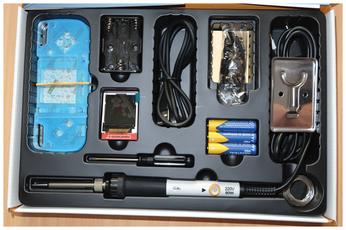Easy entry to microcontroller programming
Microcontrollers for Beginners

© Lead Image © donatas1205, 123RF.com
The Nibble kit by CircuitMess is a freely programmable mobile game console that makes getting started with microcontroller programming a breeze.
The Nibble kit by CircuitMess [1] comes with everything you need to build a portable game console. It even includes a soldering iron to solder the buttons. The lead-free solder included in the kit will easily last for several more projects. The kit also includes a simple screwdriver for assembling the case, and you won't hear this very often: The batteries are included (Figure 1).
The kit is suitable for children from nine years up, but as my test shows, older users can have fun with the kit, as well. The very detailed and easy-to-understand instructions explain all the build actions step by step. In some places, links to online videos lend further help. The assembly instructions are available for download on the manufacturer's site in several languages [2]. The Nibble kit helps users acquire a number of skills, starting with the simple act of assembling the housing, to soldering, to programming the microcontroller in C.
[...]
Buy this article as PDF
(incl. VAT)
Buy Linux Magazine
Subscribe to our Linux Newsletters
Find Linux and Open Source Jobs
Subscribe to our ADMIN Newsletters
Support Our Work
Linux Magazine content is made possible with support from readers like you. Please consider contributing when you’ve found an article to be beneficial.

News
-
Parrot OS Switches to KDE Plasma Desktop
Yet another distro is making the move to the KDE Plasma desktop.
-
TUXEDO Announces Gemini 17
TUXEDO Computers has released the fourth generation of its Gemini laptop with plenty of updates.
-
Two New Distros Adopt Enlightenment
MX Moksha and AV Linux 25 join ranks with Bodhi Linux and embrace the Enlightenment desktop.
-
Solus Linux 4.8 Removes Python 2
Solus Linux 4.8 has been released with the latest Linux kernel, updated desktops, and a key removal.
-
Zorin OS 18 Hits over a Million Downloads
If you doubt Linux isn't gaining popularity, you only have to look at Zorin OS's download numbers.
-
TUXEDO Computers Scraps Snapdragon X1E-Based Laptop
Due to issues with a Snapdragon CPU, TUXEDO Computers has cancelled its plans to release a laptop based on this elite hardware.
-
Debian Unleashes Debian Libre Live
Debian Libre Live keeps your machine free of proprietary software.
-
Valve Announces Pending Release of Steam Machine
Shout it to the heavens: Steam Machine, powered by Linux, is set to arrive in 2026.
-
Happy Birthday, ADMIN Magazine!
ADMIN is celebrating its 15th anniversary with issue #90.
-
Another Linux Malware Discovered
Russian hackers use Hyper-V to hide malware within Linux virtual machines.


